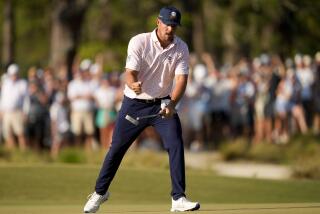HISTORY / PEBBLE BEACH
- Share via
Previous U.S. Open golf championships played at Pebble Beach Golf Links:
1972
Jack Nicklaus entered the U.S. Open as a prohibitive favorite, having beaten 25-year-old Johnny Miller in the Bing Crosby Pro-Am at Pebble Beach and also winning his fourth Masters just two months earlier. After three rounds, Nicklaus was at even-par 216 and held a one-stroke lead over defending U.S. Open champion Lee Trevino, Bruce Crampton and Kermit Zarley. With clouds in the forecast for Sunday, the USGA decided not to water the greens. What it failed to account for were strong westerly winds that dried out the course and wreaked havoc on the leaders. Nicklaus was in control until a gust nearly knocked him off his feet during his swing on No. 10, and his drive wound up on the beach. He took double bogey. Emerging from the pack was an old nemesis, Arnold Palmer, who was just two strokes back when the Open reached its pivotal point. Palmer had an 8-foot birdie putt on the par-5 14th, while Nicklaus had an 8-footer for bogey on the par-3 12th. Palmer missed, and Nicklaus made his putt to retain the lead. The margin was three shots when Nicklaus came to the par-3 17th. He hit a low 1-iron into the wind, which landed a foot in front of the hole, kissed the flagstick and stopped six inches away for birdie. He finished at 290 for a three-stroke victory over Crampton.
1982
By the end of three rounds, the second U.S. Open at Pebble Beach was shaping up to be a thriller. Twelve players were within four strokes of each other, with Tom Watson and British Open champion Bill Rogers ahead by two. Also in the mix was Jack Nicklaus, seeking his record fifth U.S. Open and third major championship at Pebble Beach. Nicklaus ran off five straight birdies starting with No. 3 and joined a four-way tie for the lead. Nicklaus and Watson separated themselves from the others as the sun began to set over the Pacific. Watson holed a 35-foot birdie putt on the 14th to take the lead, but they were tied when Watson bogeyed the 16th and Nicklaus failed to birdie the 18th. Watson tried to hit a gentle draw into the par-3 17th with a 2-iron, but it found the thick Kikuyu rough about eight feet behind the green. The ball sat up nicely enough for him to slide a sand wedge beneath it, but there was no way to control the speed running down the green. He hit a perfect pitch that hopped onto the fringe, and Watson leaned his body as it made its track to the hole, dropping for birdie -- one of the most memorable shots in U.S. Open history. Needing only a par to win, Watson hit a 9-iron to 20 feet and holed the putt for birdie and 282, a two-stroke victory over Nicklaus.
1992
Scoring records soon gave way to survival as Pebble Beach showed its fickle nature. Andy Dillard set a U.S. Open record with birdies on his first six holes. Gil Morgan opened with rounds of 66-69, and a birdie on No. 7 in the third round put him at 12 under, the lowest anyone had been in a U.S. Open. Then came the collapse. Morgan played the next seven holes in 9 over to fall into a tie with Tom Kite, and a birdie-bogey-birdie finish gave him a one-stroke lead. In a repeat of 1972, the forecast was for cloudy skies and the USGA put only minimal water on the greens. Howling winds soon turned them into concrete. The early clubhouse leader was a young Scotsman, Colin Montgomerie, whom Jack Nicklaus prematurely congratulated for winning when he finished at even-par 288. Kite would have none of it. He holed a chip for birdie on No. 7 and made a 30-footer for birdie on No. 12 to build a four-stroke lead. Bogeys on the 16th and 17th reduced his lead to two, but he parred the 18th to finish at 285 and with a two-stroke victory over Jeff Sluman.
More to Read
Go beyond the scoreboard
Get the latest on L.A.'s teams in the daily Sports Report newsletter.
You may occasionally receive promotional content from the Los Angeles Times.










